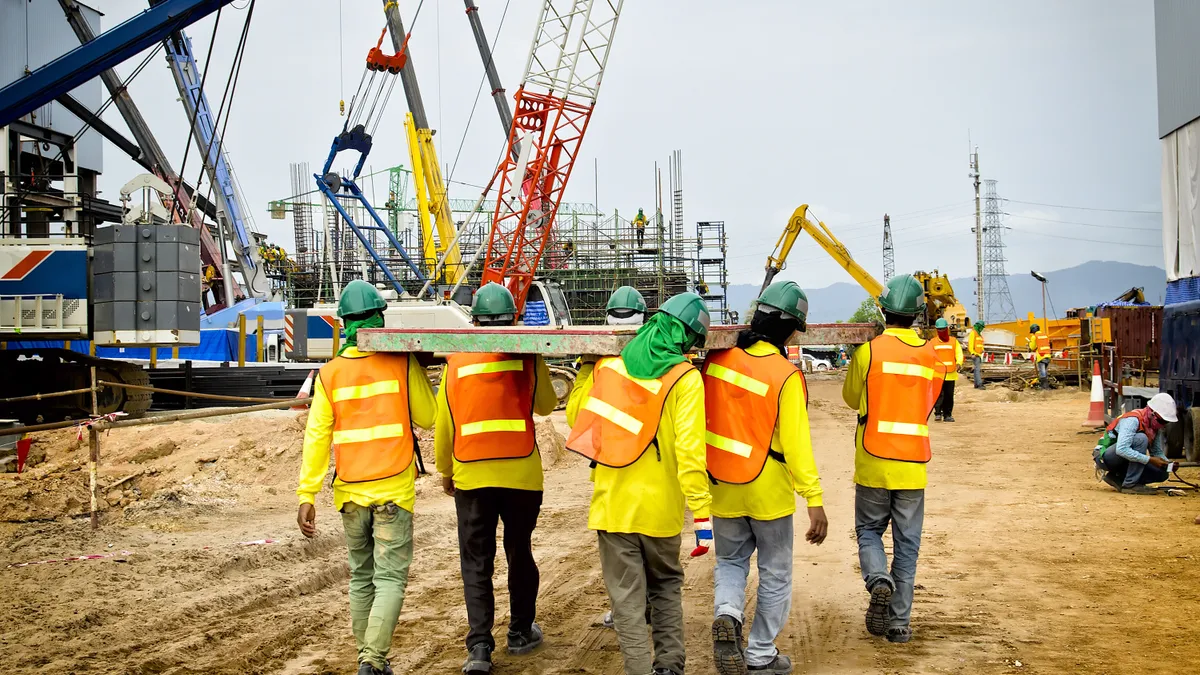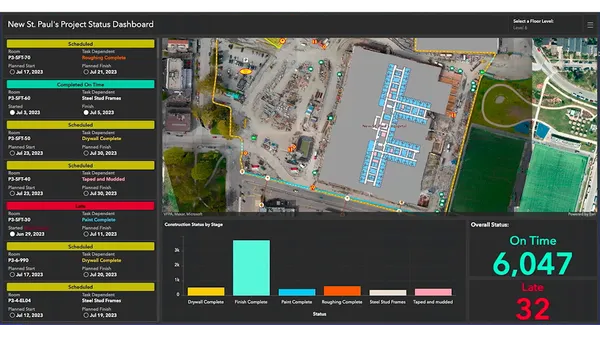Does your city or county implement workforce development goals on its public works projects? If not, should they? While perspectives on the matter vary, these initiatives can actually offer great value for both the project owner and contractor alike.
How so, you ask? That’s a great question – and one we intend to answer by looking at a case study of a recent Los Angeles World Airports (LAWA) project. But before we tackle the “how”, let’s provide a bit of context by first addressing the “why”.
The intent behind hiring goals
Why do awarding agencies and project owners implement workforce initiatives? What are they trying to achieve?
For those unfamiliar with workforce development, let’s first look at one of the more commonly practiced initiatives: local hiring. What do municipalities and other public agencies gain from having more local workers on their projects? And how do contractors benefit?
No, it’s not actually a trick question, and it doesn’t have a complicated answer either. You might have even guessed it already… Yes, local hiring increases employment and economic outcomes for a community’s own residents. But is there more to it than that?
How large construction projects can impact local economies
Given that many large prime contractors are national or multinational companies operating in a global market, it can be all too common for companies to win a bid despite having very few ties (if any at all) to a local community. In these scenarios, contractors tend to temporarily transfer core workers from out of town (or other states) - only to then relocate them again when a project is complete. When this happens, the contractor and its workers would not be reinvesting most of their incomes to stimulate local economies. Taxpayers would be paying a contractor to displace project funds and jobs to another community.
Furthermore, this does nothing to spur any growth in the supply of local skilled labor, which can be detrimental to both local contractors and the community down the line. As most anyone in public works is already painfully aware, the industry has struggled for decades to develop an adequately sized skilled workforce and attract new talent. And the deficit only widens as younger generations increasingly steer towards college education and away from blue-collar jobs – even when those blue-collar jobs provide family-sustaining wages, benefits, and economic growth. In the long run, this struggle to fully staff a project contributes to project delays and increased project costs.
Local hiring initiatives work to combat this issue. They also demonstrate the true commitment and value of a public agency’s projects to local taxpayers. And targeting residents nearby is just the start. Both public agencies and contractors can add additional value by tapping into the potential of marginalized and often under-utilized communities to increase the industry’s limited labor force. They can also provide much needed opportunities to the individuals that face barriers to employment due to excessive hardships or adversity (poverty/homelessness, prior justice system involvement, etc.)
Diversity, Equity and Inclusion in public works
Local hiring goals have picked up momentum in the last decade, but they are not the only initiatives to do so. There are other program tools that project owners implement to increase the positive economic impact of public works and provide opportunities to local workers and businesses. Project owners – private and public alike – are increasingly building Diversity, Equity, and Inclusion (DEI); Community Benefits (CB) Planning; and Social Impact (SI) initiatives into their projects.
Given the importance of learning from best practices and measuring positive impact for constituents (as well as demonstrating the value of DEI initiatives), project owners are turning to high technology solutions to track these initiatives. They are also changing how these initiatives are implemented.
Undoubtedly, tapping into new talent requires additional upfront effort in recruitment and training. The most successful programs bring together the agency, contractor, local community-based organizations, job coordinators, and workforce experts to maximize results. These partnerships are considered best practice and help make local-hiring goals both attainable and sustainable.
Let’s look at a current case study to see how these strategies can be successfully implemented...
Case Study: LAWA’s LAX Automated People Mover
Los Angeles World Airports (LAWA), the City of Los Angeles public agency that owns and operates Los Angeles International Airport (LAX), is undergoing a transformative modernization. The centerpiece of this effort is a $4.9 billion Design, Build, Finance, Operations and Maintenance (DBFOM) contract to deliver an “Automated People Mover” (APM) train that will help alleviate the burden of traffic and improve air quality in and around the airport. The APM will also connect LAX to the Los Angeles Metropolitan Transportation Authority (LA Metro) regional train system. Construction on the APM is expected to be completed in 2024.
LAWA, as the awarding body and owner of the APM project, instituted industry-leading DEI initiatives for business inclusion and workforce development. To increase their chances of winning the job, the chosen contractor added youth engagement, union dues sponsorships, and charitable contribution commitments. These commitments were integrated into the project contract to maximize the City of Los Angeles’ return on investment for the local communities.
How contractors pursuing the APM project were scored
LAWA awarded the contract based on a point system that valued inclusivity as one of the core technical criteria of the bid. In other words, contractors that were better equipped to execute the initiatives and/or to exceed minimum benchmarks would out-compete other similarly qualified contractors.
For example, LINXS, the joint venture that was awarded the APM contract, scored higher in part because of the robust metrics monitoring process – which included the designation of technology that could easily track workforce success indicators. The APM project used LCPtracker Pro, a cloud-based electronic solution that helps manage and enforce prevailing wage and workforce compliance. It allowed LINXS and LAWA to capture workforce data and then easily measure and report on successes, such as the number of workers who graduate from apprenticeships into journeypersons.
Enforcing the initiatives
To ensure that the inclusivity goals were properly implemented, LAWA needed the capability to enforce the requirements. This meant putting the initiatives in the contract language and establishing consequences for not delivering. Although LAWA’s Project Labor Agreement (PLA) sets an aspirational local hire goal of 30% on most projects, the goal was not aspirational on the APM project – it was a contract requirement. The result is that APM is one of the only projects that stayed above the 30% local hire threshold for nearly the entire duration of construction. And tracking this benchmark was as easy as running reports in LCPtracker Pro to provide community transparency on LAWA local hiring.
Apprenticeship, training, and community outreach
LAWA, as the project owner, implemented multiple programs and policies to set up this project for success. Before initiating its major infrastructure construction program, LAWA established the HireLAX Apprenticeship Readiness Program (ARP) to prepare local workers for construction careers. The HireLAX ARP is a nationally recognized - award winning program with approximately 70% of graduates finding construction employment.
One distinguishing factor of the program is its use of the rigorous curriculum developed in partnership with the Los Angeles/Orange County Building Trades Council (i.e. Unions), taught by both union trades professionals and community college educators. The other distinguishing factor of the HireLAX program is its partnership with local agencies and community-based organizations that provide wrap-around services and resources to the program participants. This helps them overcome barriers to employment, such as lack of transportation, childcare, and even the cost of work boots.
Once LINXS was selected to develop the APM project, LAWA and LINXS worked together to maximize project opportunities for apprentices from the HireLAX ARP and other local programs that recruit residents from the local communities near LAX (as well as underrepresented individuals and those facing barriers to employment.) LINXS facilitated apprentice hiring by their subcontractors, and even established a fund to assist apprentices in paying union initiation or reinstatement fees.
Was it successful?
As of July 2022, the project was on track to surpass the local hire goal with more than 30% of construction workers residing in communities near the airport. Once construction is complete, there are separate local hire requirements for the ‘Operations and Maintenance Phase’ (O&M). For O&M, the contract requires 60% local hire, which means that local residents will hold most long-term positions maintaining the APM. The O&M phase will also include an additional requirement that 10% of the workers hired be from populations of individuals categorized as “disadvantaged”, meaning that they face one or more significant barriers to employment. LAWA and LINXS will continue to work with partner agencies to connect workers to employment support resources.
Fun fact: In 2020, the Los Angeles Business Journal nominated LINXS’ Inclusivity program as Inclusivity Program of the Year for their commitments to business and workforce inclusion.
Lessons Learned: How to successfully implement DEI into your projects
Commitment comes from the top. If leadership’s heart is not in it, no one else’s will be. With the APM project, the commitment to implement diversity and inclusivity requirements started with inception of the project – the Mayor, the City Council, the CEO, and the Airport Commission all bought in. Without leadership and many stakeholders pushing for these initiatives, accountability and follow-through may falter.
Put it in the contract. It is imperative that the appropriate clauses pertaining to the workforce goals and the consequences for failing to meet them are carefully and specifically placed in the contract (and included as flow down provisions to subcontracts as well, where applicable).
Be proactive about data collection, management, and reporting. Make sure to put systems in place to track all necessary data to measure and report on progress. This needs to be coupled with proactive oversight to ensure workforce initiatives are adhered to. LCPtracker Pro was the ideal solution here in that it provides workforce transparency by leveraging data captured via its core functionality: facilitating labor compliance. Contractors submit certified payrolls through the system, and it automatically checks them for potential violations. This system is an efficient and effective way to help LAWA and prime contractors enforce compliance, increase transparency, and report on data while also helping contractors avoid costly compliance mistakes.
Cultivate inclusivity professionals. Both LAWA and LINXS established subject matter expert teams dedicated to DEI. The APM contract required that an industry-leading Inclusivity Manager be engaged on the team and maintained as key personnel throughout the project. The Inclusivity Manager acts as a liaison between the developer and project owner and oversees delivery of the developer’s DEI commitments. The two dedicated teams worked closely together and were integrated with the rest of the project management teams on either side to ensure the DEI efforts were not siloed.
With the right support, processes, and commitments in place, there’s no reason why DEI success like this cannot be replicated in other projects across the country… And there are already other success stories to share.
If you are curious about labor compliance solutions that can help with labor compliance, data management, and workforce tracking for these kinds of innovative approaches, check out www.lcptracker.com/solutions.









